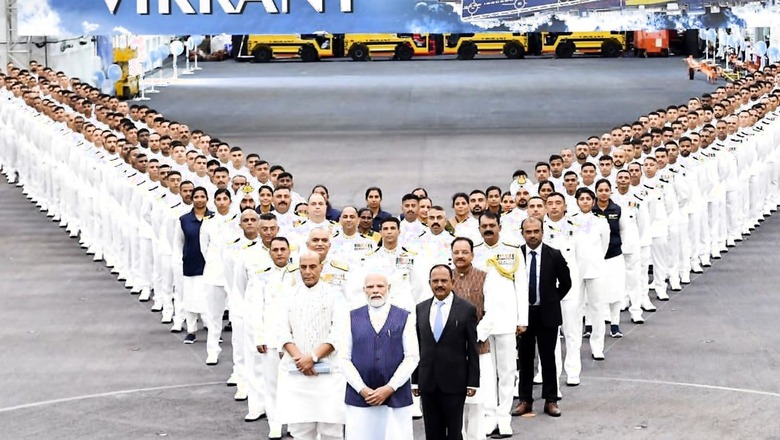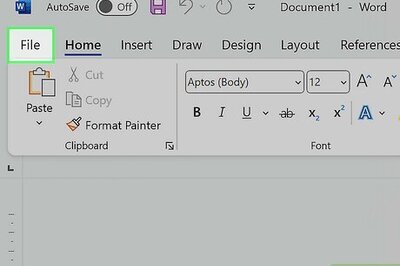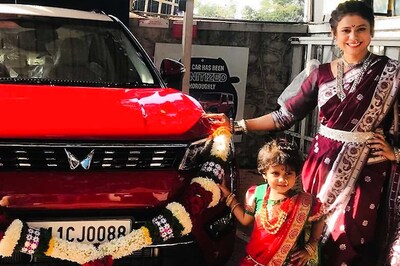
views
Prime Minister Narendra Modi on Friday commissioned INS Vikrant, India’s first Indigenous Aircraft Carrier (IAC) in Kochi, marking a significant step towards strengthening the ‘Aatmanirbhar Bharat’ goal in the strategic sector of defence.
Till today, India had only one aircraft carrier — INS Vikramaditya — which is a Russian origin platform, and is currently undergoing a major refit and is not operational. INS Vikrant will be fully combat-ready by mid-2023. The third carrier is awaiting clearance.
Here’s where the Indian Navy’s fleet strength stands — two aircraft carriers, 10 destroyers, 12 frigates and 20 corvettes.
An aircraft carrier serves as the lead vessel of what is known as a strike or battle group and being equally valuable and vulnerable, is escorted by a host of other vessels, including destroyers, submarines and supply ships, on the high seas. It is an essential part of any navy to be considered as ‘blue water navy’ – which in easy terms means that the navy with an aircraft carrier has the capacity to project that country’s power across the high seas.
THE FORCE
The Indian Navy is a multi-dimensional force that has been organized to safeguard India’s maritime territorial integrity and other maritime interests. It is headed by the Chief of the Naval Staff or the CNS. He is of the rank of Admiral and has his headquarters at New Delhi.
Aatmanirbhar Bharat – On Duty????????#INSVikrant pic.twitter.com/WfHlYzabC0— Ashwini Vaishnaw (@AshwiniVaishnaw) September 2, 2022
The Indian Navy has two Operational Commands and one Training Command — the Western Naval Command at Mumbai and the Eastern Naval Command at Visakhapatnam. The Southern Naval Command is the Training Command at Kochi. All three Commands are headed by an officer of the rank of Vice-Admiral designated as the ‘Flag Officer Commander-in-Chief’.
The major bases of the Indian Navy are located at Mumbai, Goa, Karwar, Kochi, Chennai, Visakhapatnam, Kolkata and Port Blair.
THE FLEET
The biggest ships of the Indian Navy form part of its two fleets. A fleet is a group of ships that operate under one authority. The Indian Navy’s Western Fleet is based at Mumbai and the Eastern Fleet is based at Visakhapatnam. There are also Flotillas of ships, Squadrons of submarines and various types of aircraft operated by the Navy from a number of Naval Air Stations.
The Indian Navy’s present force level comprises about 150 ships and submarines. The Indian Navy’s perspective-planning in terms of ‘force-levels’ is now driven by a conceptual shift from ‘numbers’ of platforms – that is, from the old ‘bean-counting’ philosophy—to one that concentrates upon ‘capabilities’. The Navy is acquiring ships in accordance with the current Maritime Capability Perspective Plan.
ONGOING PROJECTS
According to the Ministry of Defence website, there are more than 50 ships and submarines that are currently under construction. The preferred choice of inducting ships is through the indigenous route. For instance, the GRSE has already delivered all three of the large amphibious ships and 10 water-jet Fast Attack Craft. The yard is presently constructing advanced Anti-submarine Corvettes and has been recently awarded a contract to build LCUs.
At Mumbai, the premier warship-building yard Mazagon Docks Ltd, is engaged in the construction of Kolkata Class and P-15B destroyers, besides stealth frigate of the Shivalik Class. Submarines of the Scorpene Class are also under construction at MDL.
Goa Shipyard Limited, which has built a number of Offshore Patrol Vessels for the Navy and the Coast Guard, has advanced versions of this type under construction.
THE PRIVATE SECTOR
Over the years, the Indian Navy has taken a conscious decision to encourage other shipyards, including private yards, to enter the specialised field of warship-construction.
Contracts have been concluded with M/s Pipavav Shipyard Ltd and ABG Shipyard for construction of a few NOPVs and a couple of Cadet Training Ships, respectively.
BRIDGING THE GAP
The indigenous warships construction has come a long way since the commissioning of INS Nilgiri on June 3, 1972. There are not many countries in the world having capability to produce such a wide variety of warships ranging from fast attack craft to aircraft carrier.
However, few ships are being inducted from abroad also to bridge the gap in the capabilities envisaged in the Master Plan of the Navy. These include the carrier Vikramaditya, and follow-on ships of the Talwar Class from Russia.
INS Vikrant is an example of Government's thrust to making India's defence sector self-reliant. https://t.co/97GkAzZ3sk— Narendra Modi (@narendramodi) September 2, 2022
MID-LIFE UPGRADES
In addition, Mid-Life Upgrades (MLUs) of ships are also being progressed. After their MLU, ships of the Rajput Class as also those of the Brahmaputra Class will emerge as potent 21st Century combatants with significant residual life.
Read all the Latest News India and Breaking News here




















Comments
0 comment